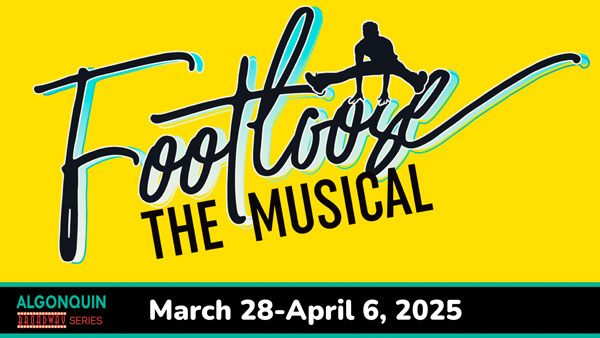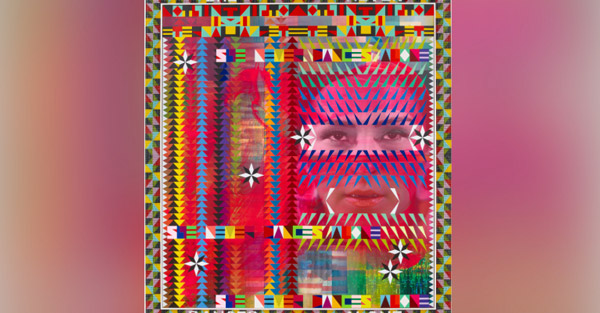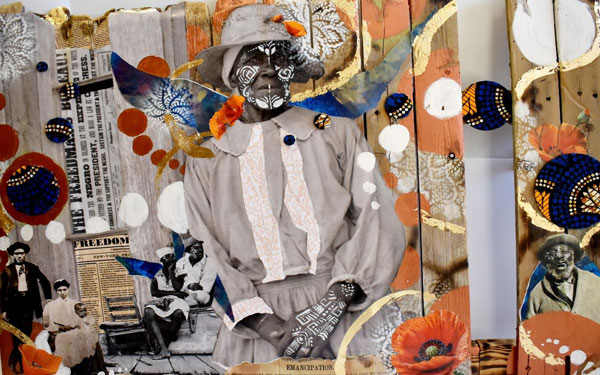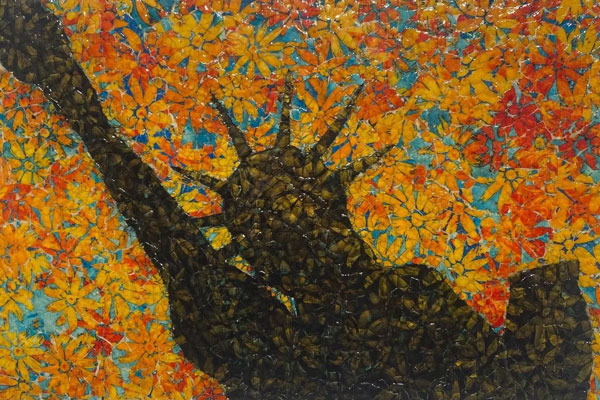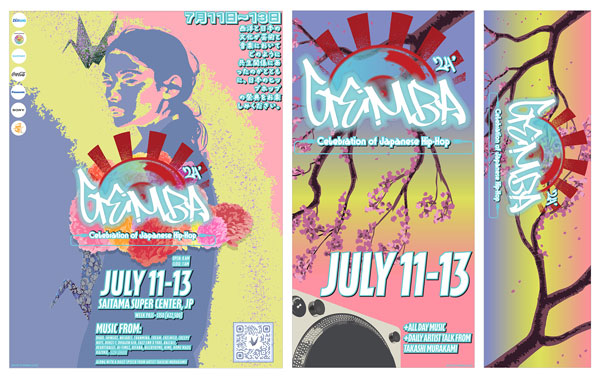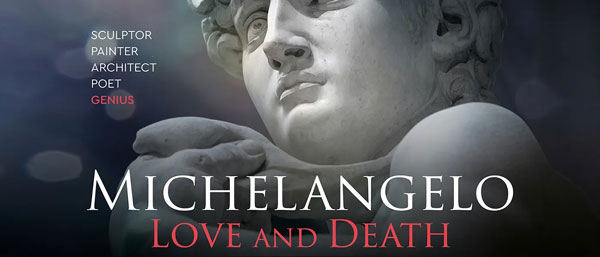By Shen Shellenberger, JerseyArts.com
originally published: 02/01/2023
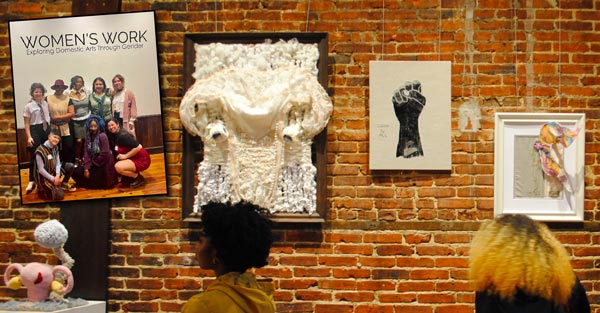
Ylvia Asal, “Spine Sperm,”“The Cocoon,” “Justice for All,” and “Gate of the Garden.” Photo by Shen Shellenberger
A 2019 Public Library of Science survey of eighteen prominent American museums revealed that over 80% of represented artists are male. This is not new. Throughout history, work by women artists has been undervalued. But, as Susan Fisher Sterling, the Alice West Director of the National Museum of Women in the Arts, told NEA Arts, there are things that people can do to help drive change. One of her suggestions is this: "Support women artists and the institutions exhibiting their work. Privilege those places that are working towards achieving gender equality."
You can do your part by visiting Camden FireWorks and seeing the current exhibition, “Women's Work: Exploring Domestic Arts Through Gender," and spreading the word about this dynamic and thought-provoking show.
"Women's Work" will be on view at the gallery through March 10, 2023, with a reception and facilitated artists' talk from 5:30 to 7:30 p.m. on the closing day.
The artists are Ylvia Asal, Alison Bermudez, Daisy Diamond, Kalila Jones, Meg Meehan, and Dana Suleymanova.
Asiyah Kurtz, Executive Director of Camden FireWorks, envisioned the idea and set out to find someone who could bring it to life. Enter artist and independent curator Zakiyah Stewart.
I asked Stewart how the connection came about between her and Kurtz. "Asiyah reached out to me on LinkedIn," she said. "She saw what I'm doing, knew about my entrepreneurial endeavors, and came to me with the pitch."
"I took the idea and ran with it creatively."
Stewart has an art history background and approached the project through the lens of women artists such as the Gee's Bend Quilters, a group of Alabama women who are making modern statements using time-honored practices.
"I had never worked with three-dimensional art before," Stewart said. "I was trying to understand women's craftmanship on a deeper level."
To achieve this objective, Stewart brought together a group of artists using practices long considered women-only spaces – knitting, crocheting, quilting, sewing, embroidery, and more – and using these mediums to make new and bold statements. "I wanted to pick a wide variety of artists and not try to connect them through their visual subject matter," she said. "What brings them together is the craftsmanship."
The works were not commissioned for this exhibition. "This is previous work," Stewart said. "The artists were already creating these things."
In addition to the artworks on display, four artists' quotes adorn the walls. Stewart told me the artists were asked this question, "In what ways has your practice helped you address inequality and stereotyping?" The quotes are the artists' answers. And in addition to bringing a greater understanding of the artists and their work, they add a personal touch.
“Although gendered expectations and pressures influence my work, they feel like one factor among many that are present.” — D. Diamond
“…BIPOC artists have been put in a box… only work around themes of adversity or hardship produced by Black hands was 'real art.'“ — K. Jones
“…making work that is playful and humorous has a role in my work being read as naïve.” — D. Suleymanova
“I know my aching is not alone, which can be relieving. Women suffering together and creating powerful things from it, and that's what I want to be part of.” — M. Meehan
"The quotes provide another way for the audience to connect with the artists," Stewart said. And that connection extends to Stewart as well. "I came away with some nuanced thoughts about that sort of work. Those responses influenced the way I talk about the show."
I also posed questions to each artist, asking about the connection between their works and the theme, their connection with the other artists, the mediums they use, which is their favorite, what the exhibition title means to them, and what is most significant to them about being part of it.
The answers – like the works of art – are unique and fascinating.
Ylvia Asal, a native of the Black Sea area of Turkey, operates a studio and store in downtown Haddonfield where she not only makes and sells her own pieces, everything from intricate jewelry to full-sized wall art, but also gives classes in lacemaking, crochet, knitting, textile art, embroidery, and fabric mosaic. Asal works in many mediums but favors needlework. "A woman is like a fabric — natural, delicate, affectionate, strong, and soft at the same time," she said. "That's why I use fabrics, threads, and many different needles." On the topic of connection with the other artists, Asal stated her thoughts simply. "It is beautiful to share this positive energy with the other artists," she said. "We women are expressing similar feelings." And the meaning of the title? "It means the silent voice of women."
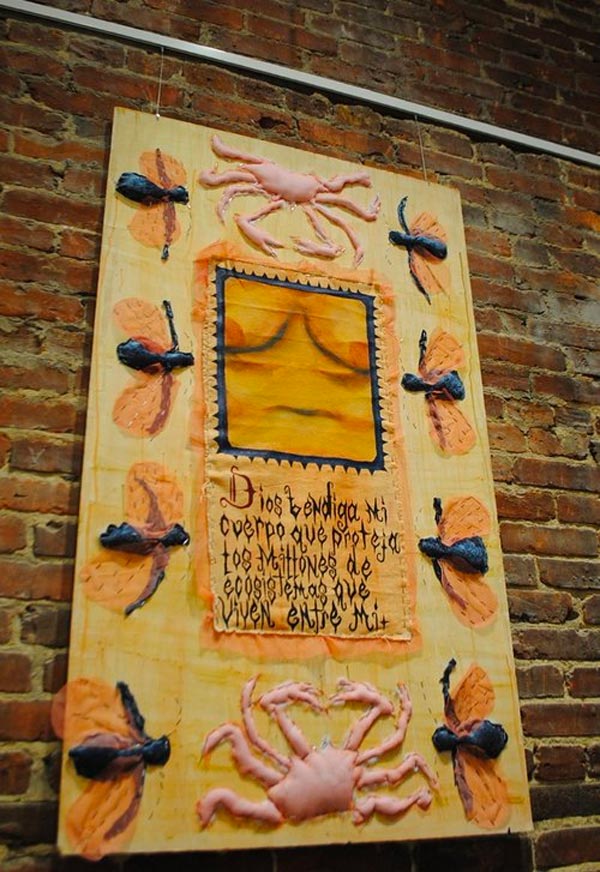
Alison Bermudez, Dios te Bendiga (God Bless You). Photo by Shen Shellenberger
Alison Bermudez spent the first eight years of her life in Costa Rica before her family moved to the United States. Her pieces in the show are part of her senior thesis exhibition, "In the Likeness of God," and they delve into ideas of religion and spirituality. Bermudez grew up in a Catholic household, and her intention with her newer work is to revise and rewrite the stories of the biblical prophets and Holy Beings in ways that allow them to be themselves. While quite different, her two works both address those themes. Bermudez calls "Dios te Bendiga" (God Bless You) a "protection piece" that features imagery and a poem in Spanish that she wrote. The other, "Mary," references the Virgin Mary and seeks to retell her story. "I humanized her and addressed the fear she must have felt when the angel came to her," she said.
She replied enthusiastically when I asked about the connection between hers and the other artists' work. "This exhibition is perfect for me. I am an aspiring art teacher and passionate about being community-oriented," she said. "In addition to being a professional arts space, Camden FireWorks feels like a community." She said she loved the opening reception, how it was attended by such a mix of people, and how important it was to her to have the chance to interact with the guests and the other artists. "The conversations I had were so influential to me as an artist."
Daisy Diamond is a Philadelphia-based artist who works with metals, textiles, drawing, painting, and found materials. "I work in craft media that have gendered associations," Diamond said. "I am less interested in creating rigid definitions of or conclusions about gender," they said. "I love objects that are ambiguous and difficult to classify." Their current body of work is not an example of "women's work." Still, by the nature of my materials, it is connected to those themes." When I asked Diamond about the personal significance of showing at Camden FireWorks, they answered, "I love the physical architecture of the gallery. A restored fire station imbues the show with a subtle connection to industrial technology." Regarding connections among the artists' works, she said, "I think our work pushes boundaries and expectations for textile and craft media."
The works by Kalila Jones are done in crochet, with one knitted piece, and they catch your attention as soon as you step into the gallery. "My work is often a form of rebellion. It's vibrant and loud while also being soft and comforting," she said. "It doesn't look like the art I grew up seeing in museums or in class," she said. "This kind of work allows for so much personal expression and creativity, and as such, I feel that my use of material speaks to the theme more than the actual subject matter."
Exhibiting at Camden FireWorks is very significant to Jones. "Like many women before me, I use craft to connect with those around me. It is so special to have the chance to present my work, speak with people about it, and hear about their relationship with textiles."
"I think being in this exhibition is doing my part to encourage the younger generation to see art more expansively." And in recent years, she noted that crocheting and similar crafts have been enjoying renewed popularity, especially among young people. A recent article in Savoir Flair stated, "Gen Z's craft obsession has not only broken down the gender stereotype that sewing, embroidery, and needlepoint are performed exclusively by women, but their DIY lockdown activities have evolved into major fashion trends. Case in point: Crochet knits."
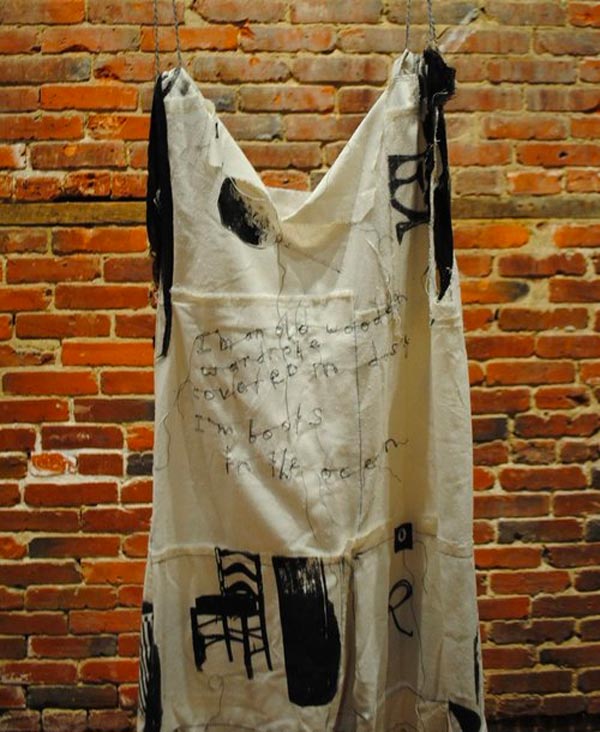
Meg Meehan, from the Threading Shells series. Photo by Shen Shellenberger
Meg Meehan is an interdisciplinary artist living in Philadelphia. Talking about the show's theme, Meehan made a critical point. "The world as we know it would not be what it is without women's handwork, art making, and touch," she said. "Learning about textiles and making my own pieces has connected me to those who paved the road before me. They help guide me."
Like the others, Meehan values the community created around those involved. "There is nothing in the world that feels stronger than women supporting each other," she said. Meehan enjoys many processes, with drawing and taking photos at the top of her list. What she has found to love most recently is free motion embroidery. "My drawings and writing can be stitched into fabric like a pencil, but it feels much more tactile and lasting," she said.
When talking about the links between her and the other artists, she raised the idea of art-making as a coping mechanism. "The artists and the work that came out of all of us together has an energy that says we needed to make these pieces when we did," she said. We couldn't cope had we not."
Born in Uzbekistan, Dana Suleymanova is an artist living and working in Philadelphia. While her work has focused on sculpture, new media, and performance, she admits that she has "always loved dabbling and seeing how different materials work together." Her pieces include a tank top made of paper, ceramic, and Mod Podge; a pair of men's-style underwear constructed of paper mâché, elastic, paint, and Mod Podge; miniature felted brassieres on ceramic hangers; and a ceramic men's tie. "Ceramics is my comfort medium. I have always worked in clay; it is like playing in the mud," she said. Lately, however, she has been trying new things. "I recently took a felting class," she said.
When I asked what is best about being in "Women's Work," the idea of community arose again. "I didn't really know any of the artists before the opening," she said, "but they have been so kind and generous, and learning about their practices and lives has been exciting." And she has found the experience of participating in the show to be inspiring. "I am encouraged to push myself to create more bodies of work." And while the theme is undoubtedly serious, Suleymanova feels like there is playfulness, too. "The artists are not afraid to experiment."
As I closed my interview with the curator, we touched briefly on the exhibition opening, which we both agreed was a joyous and affirming event, and how she feels about the theme now that the works are all on view in the galleries. "It is six people bringing together their artist statements and displaying creative ways of portraying thesubject matter and the imagery."
"It packs a punch."
Exhibition Hours — Tues–Fri, 12–5 p.m. Camden Fireworks is located at 1812 South Broadway in Camden, New Jersey.
About the author: Jersey Girl, music lover, and culture geek – Shen Shellenberger has made a career of her life-long love of the arts. From her jobs at WXPN-FM and the Philadelphia Museum of Art, to her 25 years as a freelance writer, she instills her Jersey-born roots in all she does. Whether it’s the beauty of a classic painting, the dynamics of contemporary dance, or the raw energy of rock ‘n’ roll, Shen brings her perspective to whatever she covers.
Content provided by
Discover Jersey Arts, a project of the ArtPride New Jersey Foundation and New Jersey State Council on the Arts.
FEATURED EVENTS
To narrow results by date range, categories,
or region of New Jersey
click here for our advanced search.





